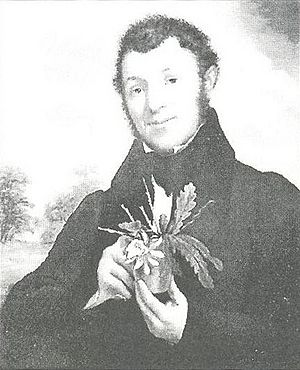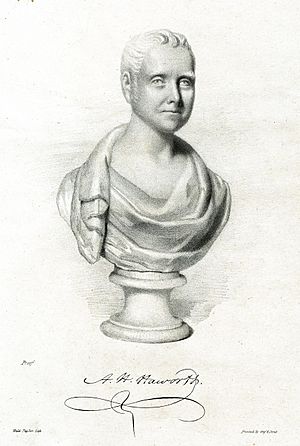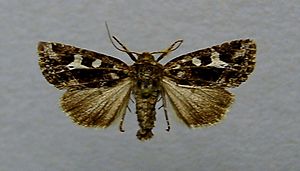Adrian Hardy Haworth facts for kids
Quick facts for kids
Adrian Hardy Haworth
|
|
|---|---|
 |
|
| Born | 19 April 1767 |
| Died | 24 August 1833 (aged 66) Little Chelsea, London
|
| Citizenship | British |
| Known for | Lepidoptera Britannica |
| Scientific career | |
| Fields | Entomology, botany and carcinology |
| Institutions | Göttingen University (Hon. DSc) |
| Author abbrev. (botany) | Haw. |
Adrian Hardy Haworth (born April 19, 1767, in Hull, England – died August 24, 1833, in Chelsea, London) was a famous English scientist. He studied insects (an entomologist), plants (a botanist), and crustaceans like shrimp (a carcinologist).
Contents
Early Life and Family
Adrian Hardy Haworth was the younger son of Benjamin Haworth. He went to Hull Grammar School. He also had private teachers. They wanted him to become a lawyer. However, after he inherited his family's property, he decided to study natural history instead. This means he spent his time learning about nature.
He was married three times during his life. His first wife was Elizabeth Sidney Cumbrey. They married in 1792. After she passed away in 1803, he married Amy Baines in 1805. She died in 1813. His last marriage was in 1819 to Elizabeth Maria Coombs. She lived longer than he did. He had children with his first wife.
Haworth's Scientific Career
In 1792, Haworth moved to Little Chelsea, London. There, he met William Jones, another naturalist. Jones greatly influenced Haworth's work. In 1798, Haworth became a member of the Linnean Society of London. This was a big step for scientists at the time.
He used the large library and plant collection of his friend, Sir Joseph Banks. Banks was a famous explorer and botanist. Haworth also often visited the Royal Botanic Gardens, Kew. These places helped him a lot with his research.
Studying Butterflies and Moths
Haworth wrote a very important book called Lepidoptera Britannica. This book was published between 1803 and 1828. It was the most complete guide to British butterflies and moths for many years. Later, Henry Tibbats Stainton wrote a new guide in 1857.
Work with Crustaceans
Adrian Haworth was also a carcinologist. This means he specialized in studying crustaceans. He was especially interested in shrimp. He gave scientific names to several groups of these animals. Some of the groups he named include:
- Order Mysida (Haworth, 1825)
- Family Mysidae (Haworth, 1825)
- Superfamily Pandaloidea (Haworth, 1825)
- Family Pandalidae (Haworth, 1825)
- Superfamily Crangonoidea (Haworth, 1825)
- Family Crangonidae (Haworth, 1825)
- Family Porcellanidae (Haworth, 1825)
He also named 22 new types of moths.
Honors and Contributions
In 1829, another British scientist, John Curtis, named a moth after Adrian Hardy Haworth. This moth is called Celaena haworthii. It belongs to the Noctuidae family.
In 1812, Haworth wrote the first paper for the Transactions of the Entomological Society of London. This paper looked back at earlier studies of British insects. In 1833, he helped start what is now the Royal Entomological Society of London. He had been the president of the group before it became "Royal." He was also a member of the Royal Horticultural Society and the Linnean Society.
Botanical Discoveries
Haworth also made important contributions to botany, the study of plants. In 1809, he wrote the first detailed study about the plant group Crocus. A whole group of plants, Haworthia, is named after him. These plants are often small and look like succulents.
Major Publications
- Synopsis Plantarum Succulentarum (London, 1812)
- Saxifragearum enumeratio (London, 1821)
- Lepidoptera Britannica (1803–1828)
- Observations on the Genus Mesembryanthemum (London, 1794)



